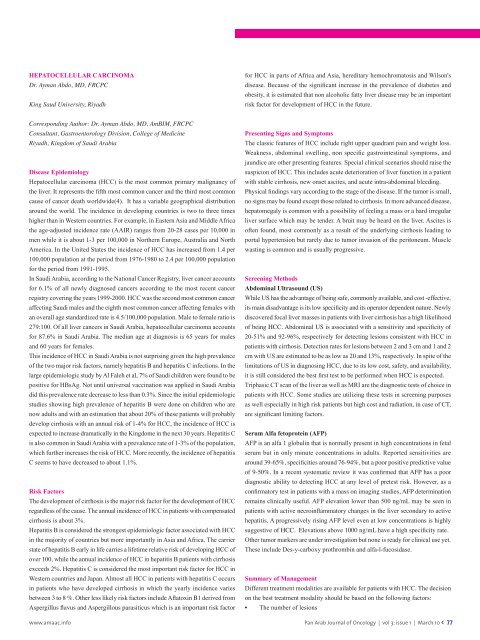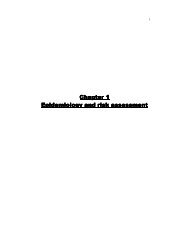Pan Arab Journal of Oncology - Arab Medical Association Against ...
Pan Arab Journal of Oncology - Arab Medical Association Against ...
Pan Arab Journal of Oncology - Arab Medical Association Against ...
You also want an ePaper? Increase the reach of your titles
YUMPU automatically turns print PDFs into web optimized ePapers that Google loves.
HEPATOCELLULAR CARCINOMA<br />
Dr. Ayman Abdo, MD, FRCPC<br />
King Saud University, Riyadh<br />
Corresponding Author: Dr. Ayman Abdo, MD, AmBIM, FRCPC<br />
Consultant, Gastroentorology Division, College <strong>of</strong> Medicine<br />
Riyadh, Kingdom <strong>of</strong> Saudi <strong>Arab</strong>ia<br />
Disease Epidemiology<br />
Hepatocellular carcinoma (HCC) is the most common primary malignancy <strong>of</strong><br />
the liver. It represents the fifth most common cancer and the third most common<br />
cause <strong>of</strong> cancer death worldwide(4). It has a variable geographical distribution<br />
around the world. The incidence in developing countries is two to three times<br />
higher than in Western countries. For example, in Eastern Asia and Middle Africa<br />
the age-adjusted incidence rate (AAIR) ranges from 20-28 cases per 10,000 in<br />
men while it is about 1-3 per 100,000 in Northern Europe, Australia and North<br />
America. In the United States the incidence <strong>of</strong> HCC has increased from 1.4 per<br />
100,000 population at the period from 1976-1980 to 2.4 per 100,000 population<br />
for the period from 1991-1995.<br />
In Saudi <strong>Arab</strong>ia, according to the National Cancer Registry, liver cancer accounts<br />
for 6.1% <strong>of</strong> all newly diagnosed cancers according to the most recent cancer<br />
registry covering the years 1999-2000. HCC was the second most common cancer<br />
affecting Saudi males and the eighth most common cancer affecting females with<br />
an overall age standardized rate is 4.5/100,000 population. Male to female ratio is<br />
279:100. Of all liver cancers in Saudi <strong>Arab</strong>ia, hepatocellular carcinoma accounts<br />
for 87.6% in Saudi <strong>Arab</strong>ia. The median age at diagnosis is 65 years for males<br />
and 60 years for females.<br />
This incidence <strong>of</strong> HCC in Saudi <strong>Arab</strong>ia is not surprising given the high prevalence<br />
<strong>of</strong> the two major risk factors, namely hepatitis B and hepatitis C infections. In the<br />
large epidemiologic study by Al Faleh et al, 7% <strong>of</strong> Saudi children were found to be<br />
positive for HBsAg. Not until universal vaccination was applied in Saudi <strong>Arab</strong>ia<br />
did this prevalence rate decrease to less than 0.3%. Since the initial epidemiologic<br />
studies showing high prevalence <strong>of</strong> hepatitis B were done on children who are<br />
now adults and with an estimation that about 20% <strong>of</strong> these patients will probably<br />
develop cirrhosis with an annual risk <strong>of</strong> 1-4% for HCC, the incidence <strong>of</strong> HCC is<br />
expected to increase dramatically in the Kingdome in the next 30 years. Hepatitis C<br />
is also common in Saudi <strong>Arab</strong>ia with a prevalence rate <strong>of</strong> 1-3% <strong>of</strong> the population,<br />
which further increases the risk <strong>of</strong> HCC. More recently, the incidence <strong>of</strong> hepatitis<br />
C seems to have decreased to about 1.1%.<br />
Risk Factors<br />
The development <strong>of</strong> cirrhosis is the major risk factor for the development <strong>of</strong> HCC<br />
regardless <strong>of</strong> the cause. The annual incidence <strong>of</strong> HCC in patients with compensated<br />
cirrhosis is about 3%.<br />
Hepatitis B is considered the strongest epidemiologic factor associated with HCC<br />
in the majority <strong>of</strong> countries but more importantly in Asia and Africa. The carrier<br />
state <strong>of</strong> hepatitis B early in life carries a lifetime relative risk <strong>of</strong> developing HCC <strong>of</strong><br />
over 100, while the annual incidence <strong>of</strong> HCC in hepatitis B patients with cirrhosis<br />
exceeds 2%. Hepatitis C is considered the most important risk factor for HCC in<br />
Western countries and Japan. Almost all HCC in patients with hepatitis C occurs<br />
in patients who have developed cirrhosis in which the yearly incidence varies<br />
between 3 to 8 %. Other less likely risk factors include Aflatoxin B1 derived from<br />
Aspergillus flavus and Aspergillous parasiticus which is an important risk factor<br />
for HCC in parts <strong>of</strong> Africa and Asia, hereditary hemochromatosis and Wilson's<br />
disease. Because <strong>of</strong> the significant increase in the prevalence <strong>of</strong> diabetes and<br />
obesity, it is estimated that non alcoholic fatty liver disease may be an important<br />
risk factor for development <strong>of</strong> HCC in the future.<br />
Presenting Signs and Symptoms<br />
The classic features <strong>of</strong> HCC include right upper quadrant pain and weight loss.<br />
Weakness, abdominal swelling, non specific gastrointestinal symptoms, and<br />
jaundice are other presenting features. Special clinical scenarios should raise the<br />
suspicion <strong>of</strong> HCC. This includes acute deterioration <strong>of</strong> liver function in a patient<br />
with stable cirrhosis, new onset ascites, and acute intra-abdominal bleeding.<br />
Physical findings vary according to the stage <strong>of</strong> the disease. If the tumor is small,<br />
no signs may be found except those related to cirrhosis. In more advanced disease,<br />
hepatomegaly is common with a possibility <strong>of</strong> feeling a mass or a hard irregular<br />
liver surface which may be tender. A bruit may be heard on the liver. Ascites is<br />
<strong>of</strong>ten found, most commonly as a result <strong>of</strong> the underlying cirrhosis leading to<br />
portal hypertension but rarely due to tumor invasion <strong>of</strong> the peritoneum. Muscle<br />
wasting is common and is usually progressive.<br />
Screening Methods<br />
Abdominal Ultrasound (US)<br />
While US has the advantage <strong>of</strong> being safe, commonly available, and cost -effective,<br />
its main disadvantage is its low specificity and its operator dependent nature. Newly<br />
discovered focal liver masses in patients with liver cirrhosis has a high likelihood<br />
<strong>of</strong> being HCC. Abdominal US is associated with a sensitivity and specificity <strong>of</strong><br />
20-51% and 92-96%, respectively for detecting lesions consistent with HCC in<br />
patients with cirrhosis. Detection rates for lesions between 2 and 3 cm and 1 and 2<br />
cm with US are estimated to be as low as 20 and 13%, respectively. In spite <strong>of</strong> the<br />
limitations <strong>of</strong> US in diagnosing HCC, due to its low cost, safety, and availability,<br />
it is still considered the best first test to be performed when HCC is expected.<br />
Triphasic CT scan <strong>of</strong> the liver as well as MRI are the diagnostic tests <strong>of</strong> choice in<br />
patients with HCC. Some studies are utilizing these tests in screening purposes<br />
as well especially in high risk patients but high cost and radiation, in case <strong>of</strong> CT,<br />
are significant limiting factors.<br />
Serum Alfa fetoprotein (AFP)<br />
AFP is an alfa 1 globulin that is normally present in high concentrations in fetal<br />
serum but in only minute concentrations in adults. Reported sensitivities are<br />
around 39-65%, specificities around 76-94%, but a poor positive predictive value<br />
<strong>of</strong> 9-50%. In a recent systematic review it was confirmed that AFP has a poor<br />
diagnostic ability to detecting HCC at any level <strong>of</strong> pretest risk. However, as a<br />
confirmatory test in patients with a mass on imaging studies, AFP determination<br />
remains clinically useful. AFP elevation lower than 500 ng/mL may be seen in<br />
patients with active necroinflammatory changes in the liver secondary to active<br />
hepatitis. A progressively rising AFP level even at low concentrations is highly<br />
suggestive <strong>of</strong> HCC. Elevations above 1000 ng/mL have a high specificity rate.<br />
Other tumor markers are under investigation but none is ready for clinical use yet.<br />
These include Des-y-carboxy prothrombin and alfa-l-fucosidase.<br />
Summary <strong>of</strong> Management<br />
Different treatment modalities are available for patients with HCC. The decision<br />
on the best treatment modality should be based on the following factors:<br />
• The number <strong>of</strong> lesions<br />
www.amaac.info <strong>Pan</strong> <strong>Arab</strong> <strong>Journal</strong> <strong>of</strong> <strong>Oncology</strong> | vol 3; issue 1 | March 10 < 77









